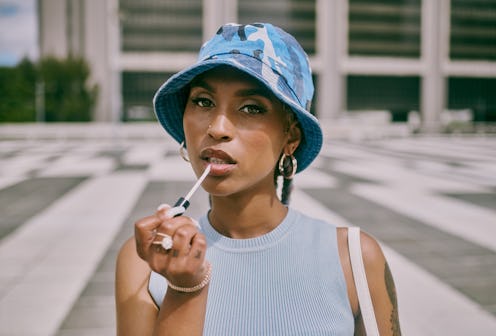
“Clean” beauty once stood more for au naturale skin remedies bottled, branded, and sold in your favorite organic food store than anything you’d find lining the shelves at luxury retailers. But today, thanks in no small part to Gen Z-ers and millennials demanding transparency, sustainability, and inclusivity across the board from brands, clean beauty has come to mean so much more.
The transformation is official: Clean beauty has graduated from crunchy niche to cool and colorful. Experts predict that the market is on track to hit $22 billion by 2024 — and with the recent influx of celebrities introducing clean lines, that figure seems all the more plausible. Within the past year, A-list trendsetters like Kylie Jenner, Issa Rae, Emma Chamberlain, and Rosie Huntington-Whiteley have all launched or reformulated clean beauty brands and lines.
The skin, soul, and planet-conscious cosmetics many have grown to expect from clean beauty brands have only grown in popularity since last year. So much has changed about the way people live and what they value. Beauty lovers are now more conscious than ever when it comes to their health. And many are getting better at showing up when it comes to important causes. Essentially, consumers have a voice — and they’re using it, which many experts believe has birthed the recent boom in demand.
First, it’s important to know that there is still no universal definition for “clean” beauty, and regulations remain lacking, especially within the U.S. The FDA currently bans only 11 chemicals from cosmetics, compared to the European Union, which bans about 1,300. But brands have taken it upon themselves to distill what makes their products clean. For Clove + Hallow founder Sarah Biggers-Stewart, it was crucial to expand her brand’s mission statements to include ethical production, ingredient transparency, and advocacy. “Clean beauty came about as a means to do better by our personal health and the planet,” says Biggers-Stewart. “It went from fringe, to popular, to industry standard, largely powered, I think, by people confronting health issues after feeling like the traditional medical system failed them.”
She agrees that the recent uptick in interest in clean beauty has likely been driven by a collective increase in awareness of health, but notes that “on the flip side, there is a growing faction of consumers and scientists coming out against clean beauty, who feel the information and data being used to market clean products is deceptive or outright untrue.” Biggers-Stewart continues that “there are lots of people reconciling their health issues right now which can quickly lead to an interest in clean beauty, and others who are backing off from clean beauty as they lean more into the data and the advice of the experts who interpret such data.”
This means that newer brands (Biggers-Stewart recently launched Clover By Clove + Hallow, a cosmetics line with a focus on sustainability) are often tasked with educating consumers about clean beauty’s most common misconceptions. “The tendency to view ingredients through a black-and-white lens of ‘natural equals good,’ ‘synthetic equals bad’ is probably the most damaging,” she adds. “It ignores science and reduces safety to the nature of origin when there is so much more to it.” Multiple factors — such as packaging, formula type, sourcing, manufacturing practices, stability, and preservative testing — go into ensuring an ingredient in a finished product is truly safe.
Charlotte Chen Pienaar — founder of Everyday Humans, a clean line of skin and sun care — has seen the impact of falsehoods in the world of SPF firsthand. “The terminology of ‘clean’ versus ‘not clean’ has created a lot of misconceptions around physical and chemical sunscreens,” Pienaar says. “Zinc oxide and titanium dioxide are physical sunscreens, while other actives are chemical. The general myth is zinc oxide and titanium dioxide sunscreens are touted as the ‘better choice’ and looked at as the ‘cleaner’ option.” She explains that this myth has led to a lot of people choosing sunscreens that might not be best suited for them. Chemical sunscreens are soluble, making them more lightweight than their zinc-based counterparts (which tend to turn into a white paste that makes melanated skin look gray or purple-ish).
New brands’ focus on inclusivity doesn’t stop at formulating products that work across a diverse range of skin tones. There are also renewed efforts to be more conscious about pricing — but formulating products with cleaner ingredients isn’t cheap. “Formulating affordable cosmetics is a challenge no matter how you slice it,” says Biggers-Stewart. “Add in the extra cost of ingredients that are more challenging to source, and it can really add up.” The bigger challenge? Each product must undergo rigorous testing. “When using alternative preservatives or natural actives, the formula is more susceptible to destabilization or a preservative failure and you may have to reformulate and retest a number of times in order to get the green light. The tests are costly upfront.” Efforts to keep price points to a minimum are making clean beauty products more accessible.
Like everything in the beauty world, the so-called clean movement is always evolving. The good thing is that it’s slowly becoming more inclusive and Earth-friendly than ever. Below, shop some Bustle-approved faves.